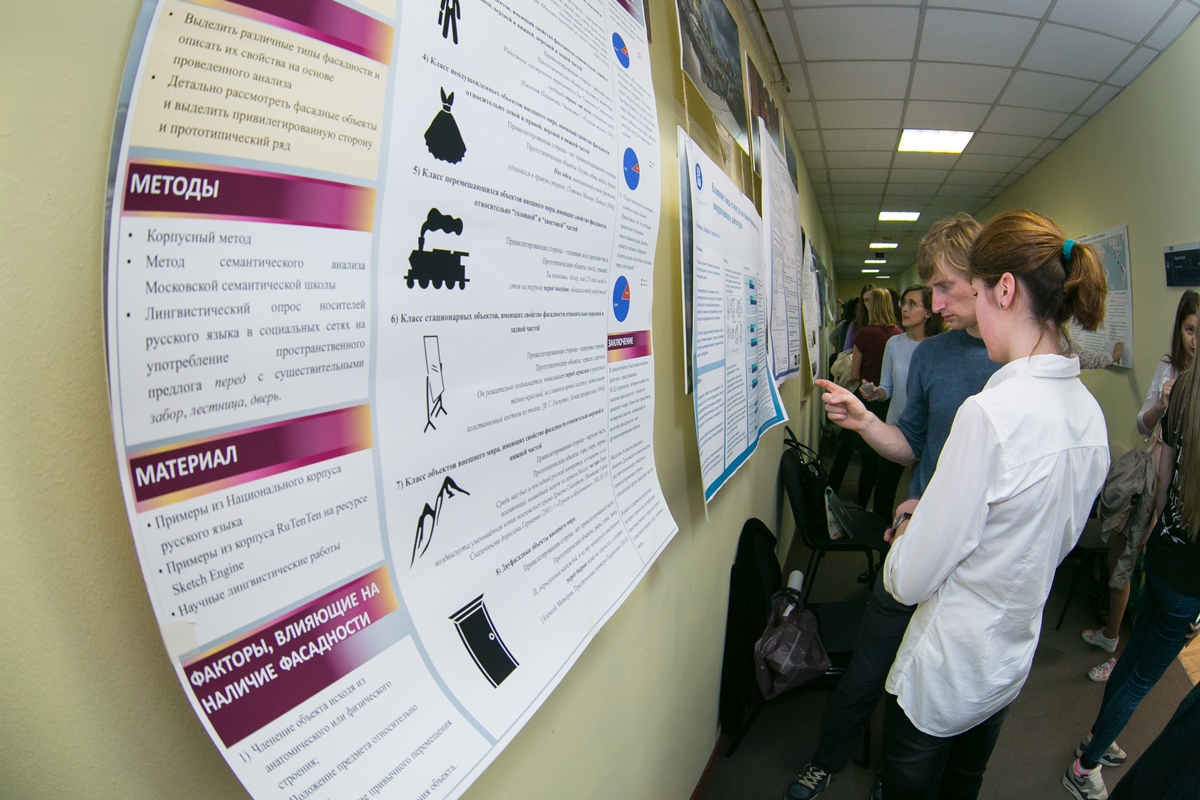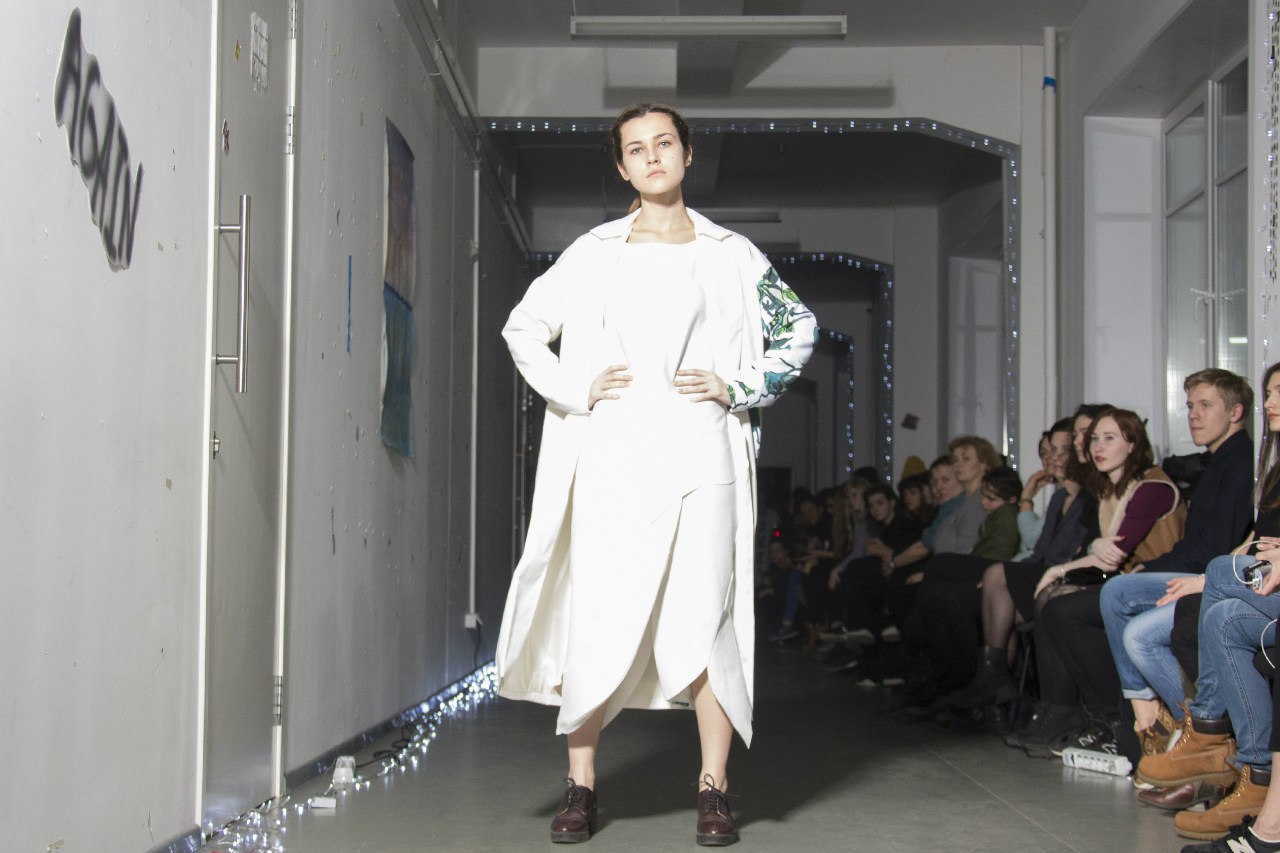Posters and Fashion Shows: The New Final Exam
This is not the first year that certain HSE programmes are giving an unusual twist to the way they give exams and carry out thesis defences. Below are a few notable examples.
Posters: From Final Project to Academic Conference
Since 2012, second-year students in the Fundamental and Computational Linguistics programme are defending their theses through posters.
This year, students hung their posters in the corridors of the School of Linguistics, as well as in a separate auditorium. The posters covered a wide range of topics and were assessed by a group of instructors. Topics included frequency epithets in the work of Pushkin; linguistic games to support Russia’s less common languages; the development of a platform for an email corpus; the learning of nouns and verbs in preschool children; the use of numerals in North, South, and Central America; and much more.

‘Posters are an important way of relaying information at contemporary conferences, and making posters is an art form that one has to learn,’ notes the programme’s academic supervisor, Yury Lander. ‘On a large poster (typically A0 or A1 size), the student typically includes summaries of their paper’s main points, as well as any illustrative materials. The poster has to be engaging and easy to read – that is, no small text. A key characteristic of a poster defence is that students discuss their work not only with instructors and classmates, but with students from other classes as well. These discussions are informal, and there’s no real time constraint.’ In this way, students are able to enter into a much more detailed discussion than they could during the ten minutes they have for questions after an ordinary paper presentation.
‘Of course, this style is frequently criticized, as posters contain much less information than, say, a PowerPoint presentation or hand-outs,’ Lander continues. ‘But on the other hand, the presenter often has the full text of a report, so those listening can become acquainted with the material right away if they want to. Another important characteristic of a “poster defence” is that the instructors are able to see as many works as possible, and not only those that they had initially chosen for evaluation. Thirdly, some posters are more like an exhibition, as they are the direct result of students’ creativity. They’re printed in different colours, and for that reason, these kinds of defences can undoubtedly be seen as a sort of academic celebration.’
The best posters are later hung on the walls of one of HSE’s auditoriums.
An Exam That Helps with Work
Beginning last year, students from the undergraduate Management programme have been solving cases for their state exams. Among other things, this method helps graduates prepare for the job recruitment process.
The final state exam, or final attestation, for undergraduate management programmes in Russia consists of two components – an oral exam and a thesis defence. But in 2013, on the initiative of the dean of the Faculty of Business and Management, Nikolay Filinov, and the head of the Degree Programmes Department, Alexandra Serova, the new case format started being developed for state exams.
Over the course of one and a half years, a group of instructors from the faculty studied the experience of leading foreign universities and professional associations before developing cases, testing them, etc. The new format was used for the first time in 2015.
Student and instructor surveys were given the first year of the new system and showed that both parties are more satisfied with the new format than the old
The state exam now consists of two sections. The first is fairly standard – a written section in the form of a test. It has closed-book questions to test a student’s knowledge of key disciplines in a particular professional field. The second section of the state exam is oral and involves solving a case. Over the course of an hour and a half, the student must prepare a presentation on his or her solution and defend it in front of a committee. The cases are based on real problems faced by companies that operate in Russia and abroad. Examples include bringing a new product to market, distributing a new product, etc.
In addition to reinforcing theoretical knowledge, the new case format allows students to master their ability to identify a management problem, select the tools and methods need to solve it, and substantiate any decisions being made.
‘This exam format is much more difficult to prepare for and complete than the traditional oral exam in management,’ notes the academic supervisor of the Management programme, Marina Dvoryashina.‘But yet student and instructor surveys were given the first year of the new system and showed that both parties are more satisfied with the new format than the old.’
Students’ positive response to the new format is largely explained by the fact that it is becoming more and more common for companies to use cases when hiring for management positions. In other words, HSE’s final examination is also an excellent way to train for the kinds of ‘tests’ that companies give.
In addition, instructors are able to provide a comprehensive assessment of their students’ knowledge and skills. ‘That being said, there has also been a significant increase in the involvement of all examination committee participants in the discussion of a case,’ Marina Dvoryashina adds. ‘The exam has truly started living up to its multidisciplinary status.’
Fashion Show: The Modern Exam

This is also not the first year that students of the HSE School of Design’s fashion programme have put on a fashion show for their final project.
‘We have made our learning process as close as possible to the real work carried out by clothing designers, and the fashion show is a key component to this process,’ comments Anzor Kankulov, who is a lecturer in the School of Design. ‘This isn’t a normal exam that tests a student’s knowledge by having them retell everything they learned throughout the year. A student’s artistic vision is what’s important to us. The fashion show is the result of students’ visual research, and it’s a way of showing the progress made by students in both the bachelor’s and master’s programmes. But this is only part of how students’ work is reviewed. Traditionally, the final review consists of two parts. The first is a standard review where a collection is presented alongside various factors in its development, such as preparatory materials, mood boards, sketches, research, and the pieces themselves. The second part is the actual show where models present a collection on the runway. A committee assesses the presentation first, and then we usually invite an audience consisting of instructors and friends.’
Students have a year to prepare the collection, and they also think of an idea or concept behind the show. Aside from actually creating the clothing, students are also responsible for other logistical aspects as well; someone is responsible for directing the show, while someone will select models, do makeup, etc. This all happens in cooperation with and under the supervision of instructors and mentors, who, if necessary, help find models, select music, and more. While working on the collection, students are also able to consult with professionals from the fashion industry.
‘Of course, the collection of first-year students isn’t as large-scale as that of the upperclassmen, but they still try to show everything they’re capable of. We see that our students truly have something to say, and their work is interesting to discuss. At each show, we are happy when we see that there are some genuinely talented designers among our students,’ Kankulov concludes.
If you are interested in seeing some of the best pieces by HSE School of Design students, you can attend the #ЗАЦЕНИВШЭ [check out HSE] project on June 30 at Tsvetnoy Central Market (Tsvetnoy Blvd, 15-1, Moscow, Russia).

